The SandForce Roundup: Corsair, Kingston, Patriot, OCZ, OWC & MemoRight SSDs Compared
by Anand Lal Shimpi on August 11, 2011 12:01 AM ESTAnandTech Storage Bench 2011
Last year we introduced our AnandTech Storage Bench, a suite of benchmarks that took traces of real OS/application usage and played them back in a repeatable manner. I assembled the traces myself out of frustration with the majority of what we have today in terms of SSD benchmarks.
Although the AnandTech Storage Bench tests did a good job of characterizing SSD performance, they weren't stressful enough. All of the tests performed less than 10GB of reads/writes and typically involved only 4GB of writes specifically. That's not even enough exceed the spare area on most SSDs. Most canned SSD benchmarks don't even come close to writing a single gigabyte of data, but that doesn't mean that simply writing 4GB is acceptable.
Originally I kept the benchmarks short enough that they wouldn't be a burden to run (~30 minutes) but long enough that they were representative of what a power user might do with their system.
Not too long ago I tweeted that I had created what I referred to as the Mother of All SSD Benchmarks (MOASB). Rather than only writing 4GB of data to the drive, this benchmark writes 106.32GB. It's the load you'd put on a drive after nearly two weeks of constant usage. And it takes a *long* time to run.
1) The MOASB, officially called AnandTech Storage Bench 2011 - Heavy Workload, mainly focuses on the times when your I/O activity is the highest. There is a lot of downloading and application installing that happens during the course of this test. My thinking was that it's during application installs, file copies, downloading and multitasking with all of this that you can really notice performance differences between drives.
2) I tried to cover as many bases as possible with the software I incorporated into this test. There's a lot of photo editing in Photoshop, HTML editing in Dreamweaver, web browsing, game playing/level loading (Starcraft II & WoW are both a part of the test) as well as general use stuff (application installing, virus scanning). I included a large amount of email downloading, document creation and editing as well. To top it all off I even use Visual Studio 2008 to build Chromium during the test.
The test has 2,168,893 read operations and 1,783,447 write operations. The IO breakdown is as follows:
| AnandTech Storage Bench 2011 - Heavy Workload IO Breakdown | ||||
| IO Size | % of Total | |||
| 4KB | 28% | |||
| 16KB | 10% | |||
| 32KB | 10% | |||
| 64KB | 4% | |||
Only 42% of all operations are sequential, the rest range from pseudo to fully random (with most falling in the pseudo-random category). Average queue depth is 4.625 IOs, with 59% of operations taking place in an IO queue of 1.
Many of you have asked for a better way to really characterize performance. Simply looking at IOPS doesn't really say much. As a result I'm going to be presenting Storage Bench 2011 data in a slightly different way. We'll have performance represented as Average MB/s, with higher numbers being better. At the same time I'll be reporting how long the SSD was busy while running this test. These disk busy graphs will show you exactly how much time was shaved off by using a faster drive vs. a slower one during the course of this test. Finally, I will also break out performance into reads, writes and combined. The reason I do this is to help balance out the fact that this test is unusually write intensive, which can often hide the benefits of a drive with good read performance.
There's also a new light workload for 2011. This is a far more reasonable, typical every day use case benchmark. Lots of web browsing, photo editing (but with a greater focus on photo consumption), video playback as well as some application installs and gaming. This test isn't nearly as write intensive as the MOASB but it's still multiple times more write intensive than what we were running last year.
As always I don't believe that these two benchmarks alone are enough to characterize the performance of a drive, but hopefully along with the rest of our tests they will help provide a better idea.
The testbed for Storage Bench 2011 has changed as well. We're now using a Sandy Bridge platform with full 6Gbps support for these tests. All of the older tests are still run on our X58 platform.
AnandTech Storage Bench 2011 - Heavy Workload
We'll start out by looking at average data rate throughout our new heavy workload test:

Our Storage Bench suite groups performers according to die count/drive capacity. The 240GB drives are faster than the 120GB counterparts. There's also not much of a difference between the drives with synchronous vs. asynchronous NAND.
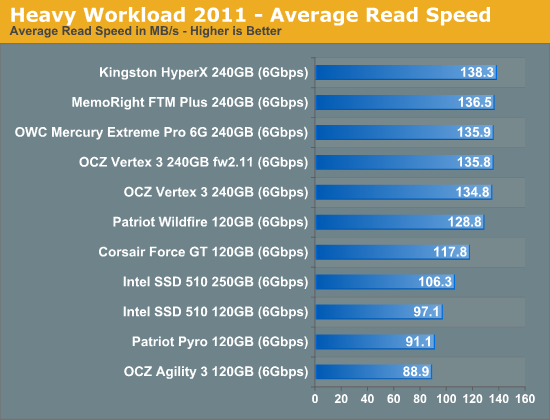
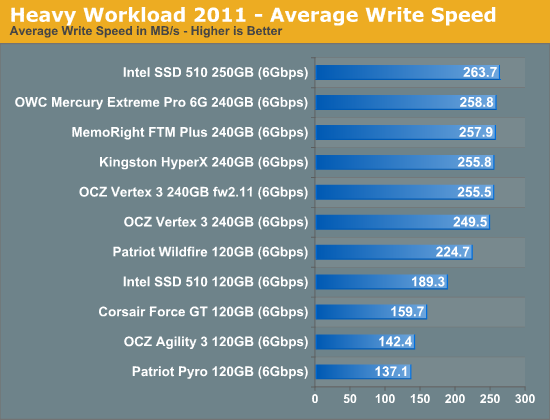
The next three charts just represent the same data, but in a different manner. Instead of looking at average data rate, we're looking at how long the disk was busy for during this entire test. Note that disk busy time excludes any and all idles, this is just how long the SSD was busy doing something:
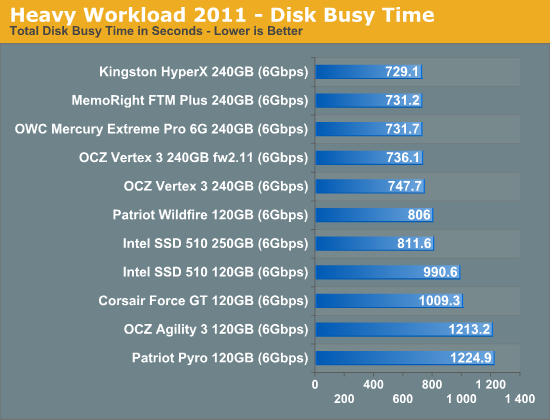
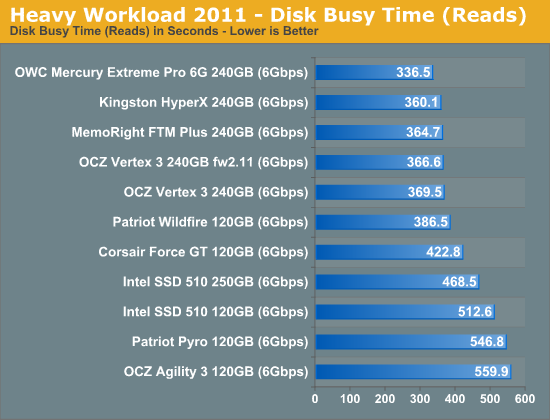
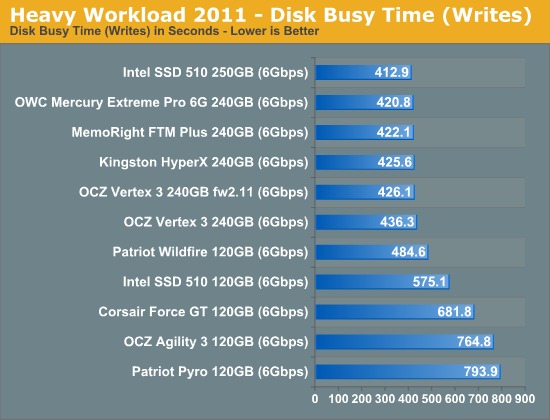










90 Comments
View All Comments
rigged - Sunday, August 14, 2011 - link
are you using the SF-2281 or SF-2282 based OWC drive?only the new 240GB and 480GB drives from OWC use this controller.
http://eshop.macsales.com/item/Other+World+Computi...
Under Specs
Controller: SandForce 2282 Series
Justin Case - Sunday, August 14, 2011 - link
It's not just the BSOD. Even systems that don't crash have frequent freezes for anything up to 90 seconds. Tht's enough to make network transfers abort, connections to game servers drop, etc..I've tried three Corsair drives on multiple platforms and I know people who have used those and also OCZ. Not a single drive was 100% stable on any platform. They tended to crash more on Intel chipsets and freeze more on AMD chipsets (sometimes recoverable, sometimes a hard lock), but NOT A SINGLE ONE was problem-free for more than 2 or 3 days in a row (often you'll get two or three freezes within the sme hour).
The first job of a drive is to reliably hold your data. People use SSDs to install their OS and applications. It takes days to reinstall and recover from errrors. It's irrelevant if some drive gives you 500 happybytes in some benchmark when the same drive keeps losing your thesis or getting you killed in Tem Fortress. I have systems with Raptors that have been running for 5 years without a single error.
If you have any problems (which you will), don't let them string you along with nonsense about your cables or obscure BIOS options or promises about future fixes. Return the drive and demand a refund. Both OCZ and Corsair are still selling drives that they KNOW to be defective, and removing any reference to those problems from the support section of their sites (you'll still find thousands of complaints in their user forums, though). Demanding refunds (or starting a class action suit) seems to be the only language they understand.
SjarbaDarba - Sunday, August 14, 2011 - link
I experience some hard locks too, mainly during gaming only since upgrading to a 120GB Vertex 3.System is an X58-UD7 + i7-960, 2 GTX570 OC Sli, Seasonic X-850 80+ GOLD, 6GB Corsair DDR3 1600C8.
Was originally using 2 x 300GB Velociraptors in RAID 0 with WD1002FAEX and Seagate 2TB XT, stable for 1-2 months before upgrading to the V3. Storage configuration since upgrade is 120GB Vertex3, WD1002FAEX and Raptors RAID 0.
System perfectly stable under 600GB RAID 0 OS with Crysis 2, CS:S, LoL, L4D, L4D2 and Borderlands all playing stable at all loads with hardware monitoring active, no problems found with any hardware or software at this point, system performed flawlessly for all tasks.
Dropped the V3 in with the typical "It's fast - but it could be faster" attitude we all know and love and instantly started experiencing ... whackness. System works flawlessly 99% of the time, however, a few times a week I will lock up and need to power cycle - I have the SSD running in AHCI with TRIM etc. enabled, page file, defrag etc. turned off and pretty much every detail of the drive perfectly specced for optimum performance.
If I lock up and have to cycle, upon restart the SATA controller the SSD is attached to will hang at BIOS and not detect the V3 - however - cycling again at this point allows the SSD to be detected within ~1 second and Windows boots normally.
At this point, however (and using nVidia 275.33 drivers) returning to desktop boots me in 800x600 resolution with no nVidia control panel and a further power cycle is required again to reset the resolution.
Yet to test this problem with nVidia 280.16 drivers but havn't had stability problems since then.
Sorry for any tl;dr, just thought Annad might like to hear about a strange error I've encountered in the SF controller.
P.S: System is 3DMark, Furmark and Prime stable, it just has some whack locks randomly and the SSD disappears completely for a power cycle.
readyrover - Monday, August 15, 2011 - link
I was going to dive into my first SSD with a Bulldozer build on the upcoming horizon...until this all shakes out...absolutely no way. My usage is for processing large music files on a Digital Audio Workstation with multiple time based effects and multi-tracks of instruments. I have been experiencing some latency bottle necks and thought "wow" ssd is an instant fix!If they have ironed out the problems and the reviews' negative percentages drop back below an astounding 20% of my recent research..then perhaps a year from now...Bulldozers should be less expensive then as well..
Just my humble opinion, but I can't roll the dice on a hit and miss crash...."Please Mr. $120 hour guitarist...would you wait an hour for me to fix the computer and replay that absolutely inspired, one of kind improvisation...AGAIN!
Brrrr...shiver...run away fast!
Gothmoth - Friday, August 19, 2011 - link
i have a few asus z68- v pro boards (three to be exact).all of them have an vertex3 120 GB SSD as C drive.
all have 16 GB g.skill ram and run win 7 64 bit sp1.
i had not a single issue with the vertex 3 since i bought them (13. april 2011).
i have still the first firmware running.
thank god i have avoided updating to firmware v2.06 or v2.09.
i have put the vertex3 240 GB from a friend in my system with firmware 2.06.
we could reproduce the BSOD after 1 hour.
he has constand crashes on his gigabye motherboard based system.
we but one of my vertex3 120GB SSD in his system and it was running flawless for 2 days.
twindragon6 - Friday, August 26, 2011 - link
I know the market sucks! But I would rather pay more for something that actually works than pay less for something that doesn't and be stuck with an expensive paperweight!alpha754293 - Friday, September 2, 2011 - link
Anand:Does that BSOD bug only affect drives that are boot drives? i.e. What would happen if the test drives were slave/data/non-OS-containing drives? Does it still do the same BSOD thing?
Keith2468 - Monday, December 12, 2011 - link
Digital people tend to think digital issue when looking for the causes of computer hardsware and software failure. But sometimes the failures are not digital in origin.The power supply may well be critical to SSD failures.
What causes SSD failures? Largely power disturbances to the SSD.
Why are SSDs with smaller IOPS and smaller caches less likely to fail?
Less data to move from volatile RAM cache to Flash when power disturbances occur.
Why should you not use a notebook SSD in a desktop?
A notebook SSD designer will typically assume that the notebook's battery means he doesn't have to design for power distrubances.
"The design of an SSD's power down management system is a fundamental characteristic of the SSD which can determine its suitability and compatibility with user operational environments. Systems integrators must take this into account when qualifying SSDs in new applications - because subtle differences in OS timings, rack power loading and rack logic affect some types of SSDs more than others. Users should be aware that power management inside the SSD (a factor which doesn't get much space in most product datasheets) is as important to reliable operation as management of endurance, IOPS, cost and other headline parameters."
http://www.storagesearch.com/ssd-power-going-down....
jfraser7 - Friday, November 14, 2014 - link
This article is very useful because Mac OS X 10.10 Yosemite dropped all support for third-party Solid State Drives, except for those which use SandForce controllers.jfraser7 - Friday, November 14, 2014 - link
Also, all three of Kingston's recent Solid State Drive lines(V300, KC300 & HyperX) use SandForce controllers.